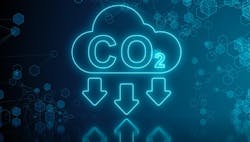Surface Layer Improves Carbon Dioxide Capture
Researchers at North Carolina State University (NCSU), Raleigh, N.C., and SINTEF Industry, an independent research organization in Trondheim, Norway, have developed a new membrane technology that allows for more efficient removal of carbon dioxide (CO2) from mixed gases.
Their development addresses a longstanding challenge for such membranes — the trade-off between permeability and selectivity; the higher the permeability, the lower the selectivity, resulting in relatively less CO2 captured.
The research team addressed this problem by growing chemically active polymer chains that are both hydrophilic and CO2-philic on the surface of existing elastomeric polydimethylsiloxane (PDMS) and glassy polytetrafluoroethylene (PTFE AF) membranes. This increases CO2 selectivity and causes relatively little reduction in permeability.
To demonstrate the new membranes’ capability, the team looked at mixtures of CO2 and nitrogen, and mixtures of CO2 and methane.
“In short, with little change in permeability, we’ve demonstrated we can increase selectivity by as much as about 150 times,” says Marius Sandru, senior research scientist at SINTEF. “So we’re capturing much more CO2, relative to the other species in gas mixtures.”
More details appear in the journal Science.
“The CO2-selective polyamine surface-grown layer is strongly chemically bound to the substrate surface and becomes an integral part of the PDMS or PTFE AF membrane. This layer is not just simply physically adsorbed or coated to form a new and separate layer, as is the case of conventional thin-film composite CO2 separation membranes, thereby completely eliminating the possibility that the CO2-selective layer can be washed away or delaminate. … We performed long-term testing without significant performance drop: up to several thousand hours at various pressures (1.2 to 5 bar), various temperatures (25 to 55 °C) and various humidity levels of feed gas,” says Rich Spontak, a professor of chemical and biomolecular engineering and, materials science & engineering at NCSU.
Engineering the surface of these membranes to improve selectivity does increase the cost, admit the researchers, who emphasize the modified membranes will still be more cost effective than “premium” membranes on the market. “The high-permeability substrate membranes we selected (namely, PDMS and PTFE AF) are already commercially available at low cost. The surface modification is facile and scalable without requiring expensive chemicals,” elaborates Spontak.
The research offers opportunities to explore surface treatments for other separations, but Spontak says his team is focused primarily on CO2 separation. “Since good CO2/N2 separation typically translates to good CO2/H2 separation and with a rekindled interest in an H2 economy, this is an important direction to consider in the near future,” he adds.
“The concept is new and we anticipate it will take time for industry to realize the value of our contribution. We believe the most likely road for commercialization and implementation of these surface-functionalized membranes will involve a large membrane producer to license SINTEF intellectual property or other modalities,” reckons Spontak.
To implement on a larger scale, automated industrial production of the surface-functionalized membranes is needed. “Other considerations that must be addressed in next-stage upscaling include membrane module design, packing density and optimum operational conditions. Topics such as these require further investigation and analysis,” Spontak notes.
At the present time, Sandru and SINTEF continue the work of upscaling the membranes first for CO2/N2 separation from flue gas, as well identification of other suitable CO2 mixed-gas streams to separate (such as CO2/H2).
